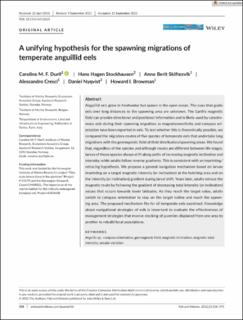| dc.contributor.author | Durif, Caroline | |
| dc.contributor.author | Stockhausen, Hagen | |
| dc.contributor.author | Skiftesvik, Anne Berit | |
| dc.contributor.author | Cresci, Alessandro | |
| dc.contributor.author | Nyqvist, Daniel | |
| dc.contributor.author | Browman, Howard | |
| dc.date.accessioned | 2022-03-02T12:04:00Z | |
| dc.date.available | 2022-03-02T12:04:00Z | |
| dc.date.created | 2022-02-11T11:10:21Z | |
| dc.date.issued | 2021 | |
| dc.identifier.citation | Fish and Fisheries. 2021, 23 (2), 358-375. | en_US |
| dc.identifier.issn | 1467-2960 | |
| dc.identifier.uri | https://hdl.handle.net/11250/2982465 | |
| dc.description.abstract | Anguillid eels grow in freshwater but spawn in the open ocean. The cues that guide eels over long distances to the spawning area are unknown. The Earth's magnetic field can provide directional and positional information and is likely used by catadromous eels during their spawning migration; as magnetosensitivity and compass orientation have been reported in eels. To test whether this is theoretically possible, we compared the migratory routes of five species of temperate eels that undertake long migrations with the geomagnetic field of their distribution/spawning areas. We found that, regardless of the species and although routes are different between life stages, larvae of those species always drift along paths of increasing magnetic inclination and intensity, while adults follow reverse gradients. This is consistent with an imprinting/retracing hypothesis. We propose a general navigation mechanism based on larvae imprinting on a target magnetic intensity (or inclination) at the hatching area and on the intensity (or inclination) gradient during larval drift. Years later, adults retrace the magnetic route by following the gradient of decreasing total intensity (or inclination) values that occurs towards lower latitudes. As they reach the target value, adults switch to compass orientation to stay on the target isoline and reach the spawning area. The proposed mechanism fits for all temperate eels examined. Knowledge about navigational strategies of eels is important to evaluate the effectiveness of management strategies that involve stocking of juveniles displaced from one area to another to rebuild local populations. | en_US |
| dc.language.iso | eng | en_US |
| dc.title | A unifying hypothesis for the spawning migrations of temperate anguillid eels | en_US |
| dc.type | Peer reviewed | en_US |
| dc.type | Journal article | en_US |
| dc.description.version | publishedVersion | en_US |
| dc.source.pagenumber | 358-375 | en_US |
| dc.source.volume | 23 | en_US |
| dc.source.journal | Fish and Fisheries | en_US |
| dc.source.issue | 2 | en_US |
| dc.identifier.doi | 10.1111/faf.12621 | |
| dc.identifier.cristin | 2000372 | |
| dc.relation.project | Havforskningsinstituttet: 15579 | en_US |
| dc.relation.project | Norges forskningsråd: 280658 | en_US |
| cristin.ispublished | true | |
| cristin.fulltext | original | |
| cristin.qualitycode | 2 | |
